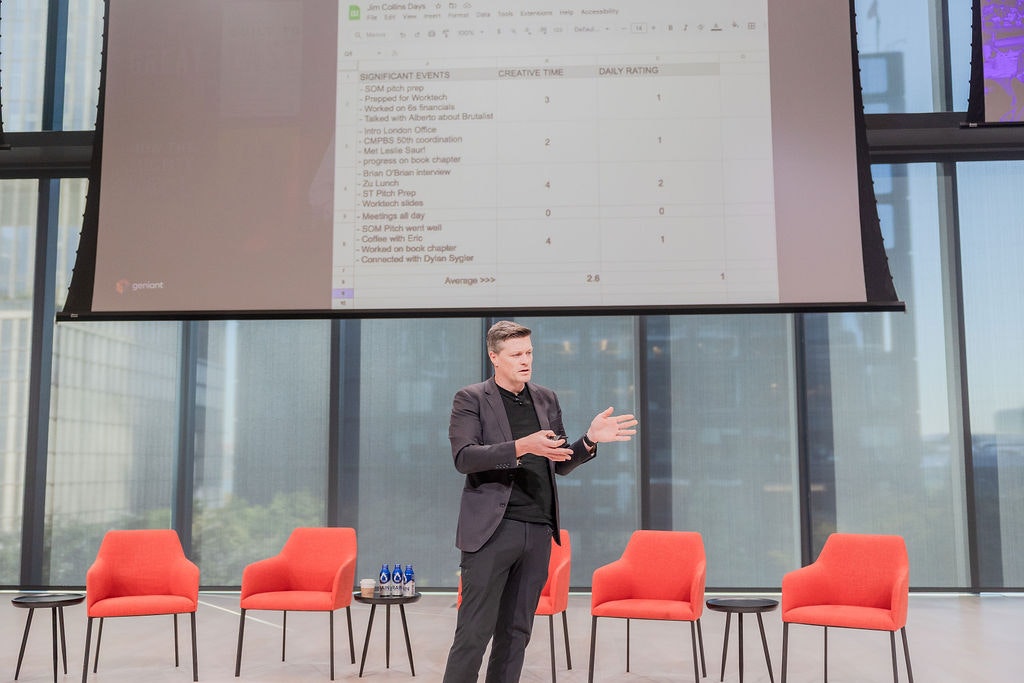The edge of change: how New York’s leaders are navigating uncertainty
From the rise of AI to growing pressure on performance, WORKTECH New York 2025 explored the defining tensions reshaping work and showcased best-in-class ways for organisations to address them
As organisations navigate an era defined by technological acceleration, economic uncertainty and shifting employee expectations, the workplace has become both a symbol of change and a testing ground for how it can happen.
Against this backdrop, the WORKTECH New York 2025 conference on 6 October 2025 convened global thinkers, corporate leaders and technologists inside BlackRock’s new global headquarters in midtown Manhattan, which offered a fitting venue for a dialogue about transformation.
Across the day, several key themes emerged, from the rise of AI and its implications for human capital, to the role of culture in performance and the growing importance of data-driven design. The conference highlighted both the potential for and urgent need to take change into our own hands amid increasing machine input.
Human capital paradox
The conference opened with a keynote discussion between Arun Sundararajan, professor at New York University and Peter Miscovich, global future-of-work leader at JLL. The conversation centred on how to maintain a sustainable workforce as machines continue to enter the job market.

Arun Sundararajan, professor at New York University (left) and Peter Miscovich, global future-of-work leader at JLL (right) in discussion.
Currently, 50% of labour is human, but by 2030 that figure could drop to 30%. AI will most immediately disrupt early-career roles, eroding traditional entry points into the workforce. Sundararajan warned that we are underinvesting in early-career development and decoupling human skills from value creation.
The next sustainability challenge, this opening session concluded, will be workforce sustainability itself. Organisations and governments need to ensure that people can adapt, reskill and remain valued in an AI-driven economy.
A discussion with Anna Tavis (NYU), Brett Martin (Columbia Business School) and Tim Walding (PwC), further amplified the message that organisations need to prepare for the influx of AI co-workers. They discussed the process of ‘Assist, Automate, Augment, Redefine’ and urged organisations to move beyond simple automation to explore how AI can help humans learn, grow and collaborate differently. As Martin noted, ‘There’s a new bar of collaboration – can I do this by myself, with AI as my partner?’
Strategic innovation
A standout case study came from investment group BlackRock, whose new 15-floor New York headquarters for 4,000 employees has been hailed as an exemplar of flexible, data-informed workplace strategy. With private offices reduced from 35% to just 10-15%, the space prioritises open collaboration and adaptive use.
By using platforms such as Saltmine and real-time occupancy data, the company can test spatial changes virtually before implementation. The result is a workplace that has sustained 70-75% occupancy on peak days, with design flexibility built in from the start rather than retrofitted later.
Biopharma company Sanofi presented another benchmark for large-scale transformation. Sanofi’s global workplace programme repositions the office as a culture and wellbeing enabler built on four pillars: culture and collaboration; sustainability and wellbeing; technology and innovation; and hospitality and workspace.

Fernando Faria of Sanofi (left) and Shivaun Ryan of XY Sense (right) discussing Sanofi’s global workplace strategy.
Sanofi is working with XY Sense to amplify its data-led design. By tracking this data, the company can see that workstation utilisation has increased from 41% to 79% and waste has been reduced. The design introduces sensory elements such as smell, sound and touch to foster belonging. Sanofi launched a LinkedIn campaign around its new office design which has received over 32 million LinkedIn impressions, positioning its workplaces as brand assets as much as physical environments.
Culture and performance
Author of the book The Performance Culture, Khalil Smith explored how culture can shape people’s perception of the workplace and their organisation. As trust in institutions declines globally – according to data by Edelman – companies remain one of the last bastions of public confidence. Successful return-to-office strategies, Smith argued, depend less on spatial redesign than on rebuilding cultural trust and shared language, making inclusion deliberate and measurable.

David Dewane of Genient explaining the ‘Collins Index’ concept
Adding an anthropological lens, David Dewane, the chief experience officer at Genient, proposed a ‘science + art’ approach to workplace design. Science gathers insight; art shapes solutions. Dewane has devised a ‘Collins Score’ which offers a new way to quantify human flourishing. The score aims to identify patterns which signal a ‘good working day’ versus a ‘bad working day’. Using this data, individuals can start making informed decisions around designing out bad experiences at work.
Flexibility as a metric
Data also underpinned insights from the Global Workplace Flexibility Index, a collaboration between WORKTECH Academy and Vecos, analysing over one million connected smart lockers worldwide. Findings show flexibility maturity highest in the Netherlands, Scandinavia and Australia, with the US expected to rise 10% in the next five years.
Flexible systems are enabling organisations to halve storage ratios (from >1:1 to 0.5:1) while improving space efficiency and user experience. Notifications alone can increase locker turnover from 53% to 94%. Beyond logistics, the research reframes flexibility as a lever for empowerment and sustainability, not just cost control.

Kasia Maynard of WORKTECH Academy (left) and Saskia Ordelman of Vecos (right) discussing the Global Workplace Flexibility Index
New frontier for digital collaboration
Google, HP, and Zoom unveiled Google Beam, in a panel discussion with UnWork CEO Philip Ross. Google Beam is an AI-powered video platform designed to recreate the realism of face-to-face meetings. Combining AI-driven 3D rendering and multi-camera capture, Beam enables lifelike, latency-free interaction through a ‘magic window.’ Early research shows significant gains in engagement and recall, and less fatigue compared to traditional video calls which marks a potential leap forward in hybrid collaboration.
The experience equation
There were several references to elevating employee experience across the conference, but a conversation between Dan Drogman (CEO of Smart Spaces) and Mauricio Tolado (global head of workplace experience at Warner Music Group) explored the essence of what makes a great workplace experience.
A great experience, they agreed, means frictionless functionality where technology fades into the background and the environment simply works. Tolado highlighted challenges of limited budgets, generational differences in tech adoption, and integrating multiple systems across more than 270 sites. Drogman described how Smart Spaces creates seamless, global consistency by uniting landlord and tenant systems through one platform and using AI, including the ‘Max’ space agent, to simplify data and improve decision-making.
Ultimately, a great experience goes beyond fixing problems and focuses on anticipating needs, connecting people, and making the workplace feel effortless. As AI transforms productivity, culture, and design, the challenge for organisations is to strike an equilibrium between human and machine, cost and experience, autonomy and belonging.
There was a clear theme from the New York conference that technology shouldn’t be deployed for its own sake – it requires purposeful, human-driven use cases to fix existing tensions and challenges in the workplace. New York’s leaders are clearly looking for balance.








